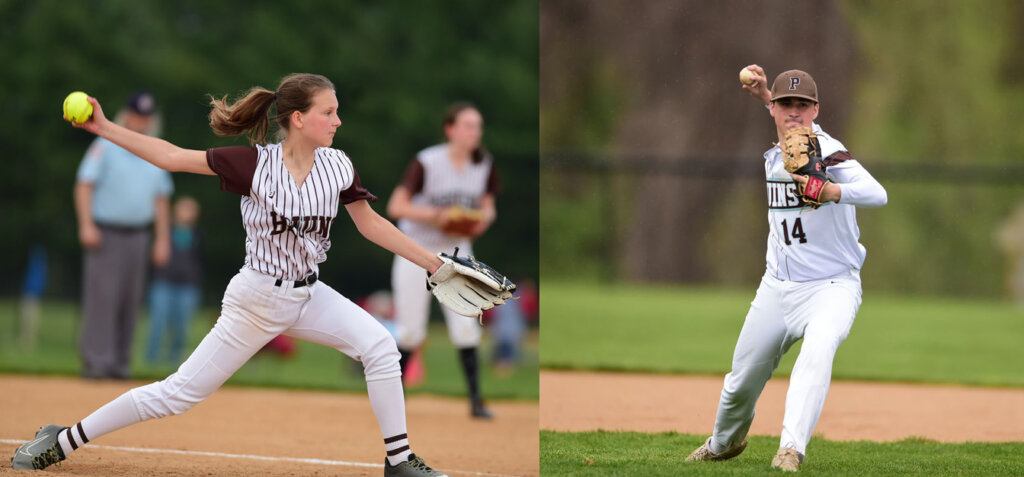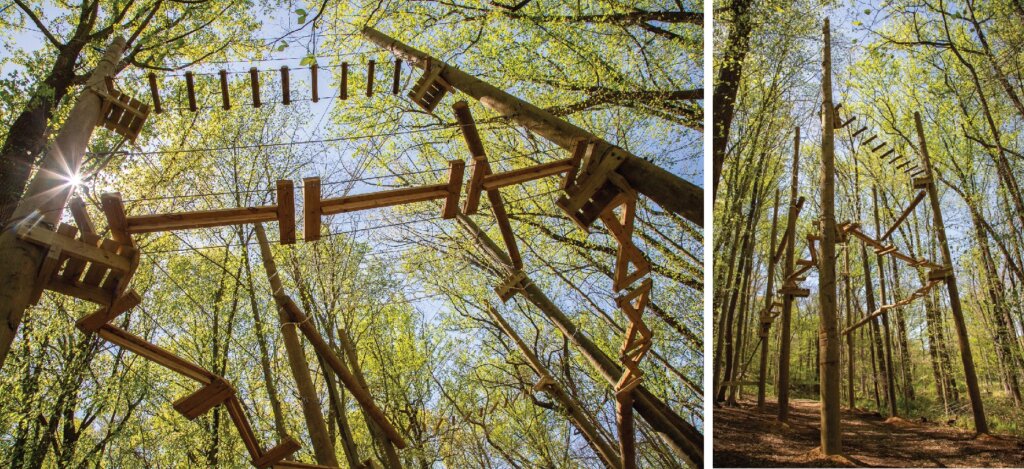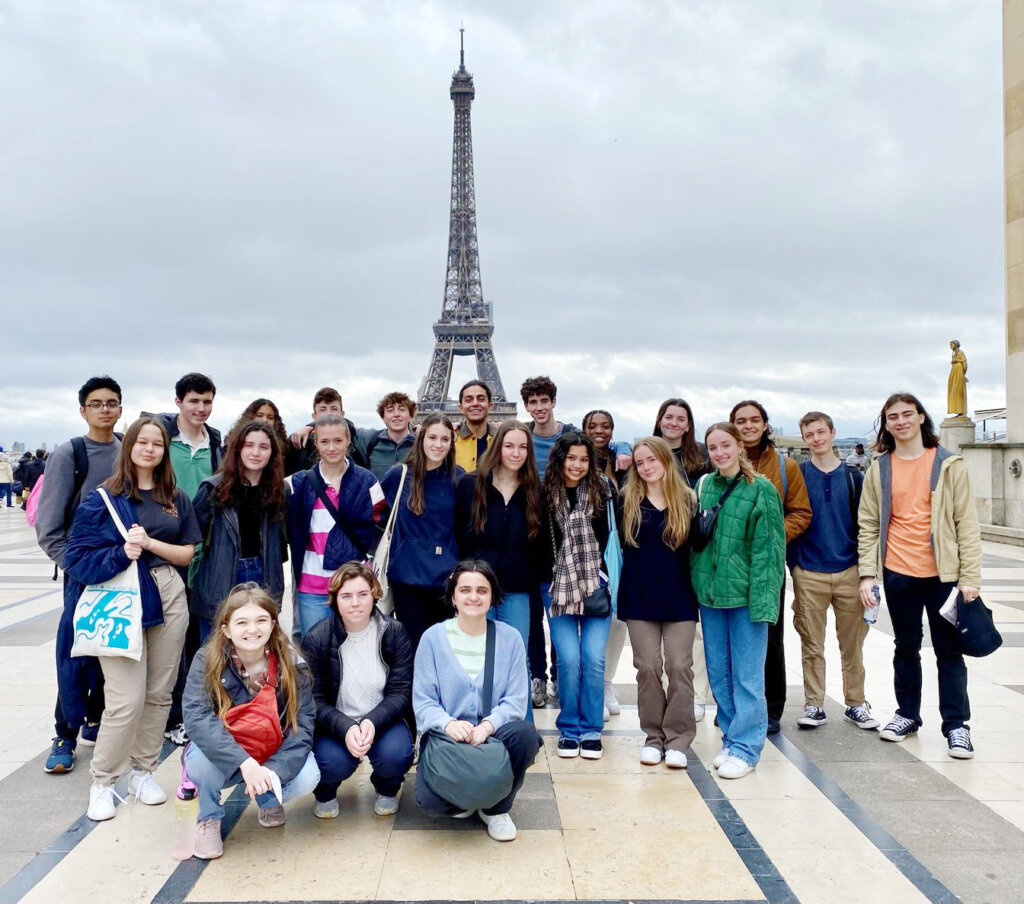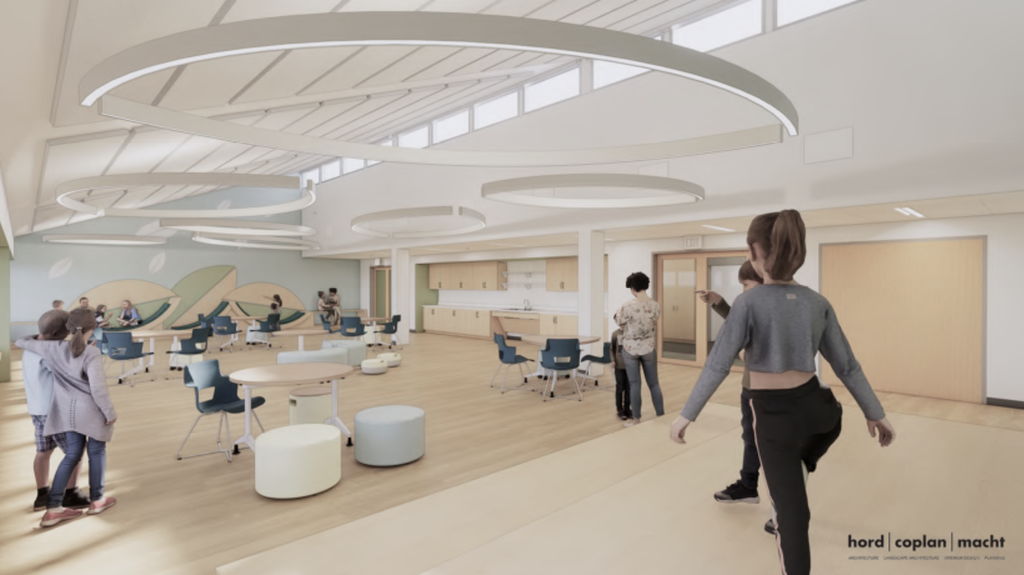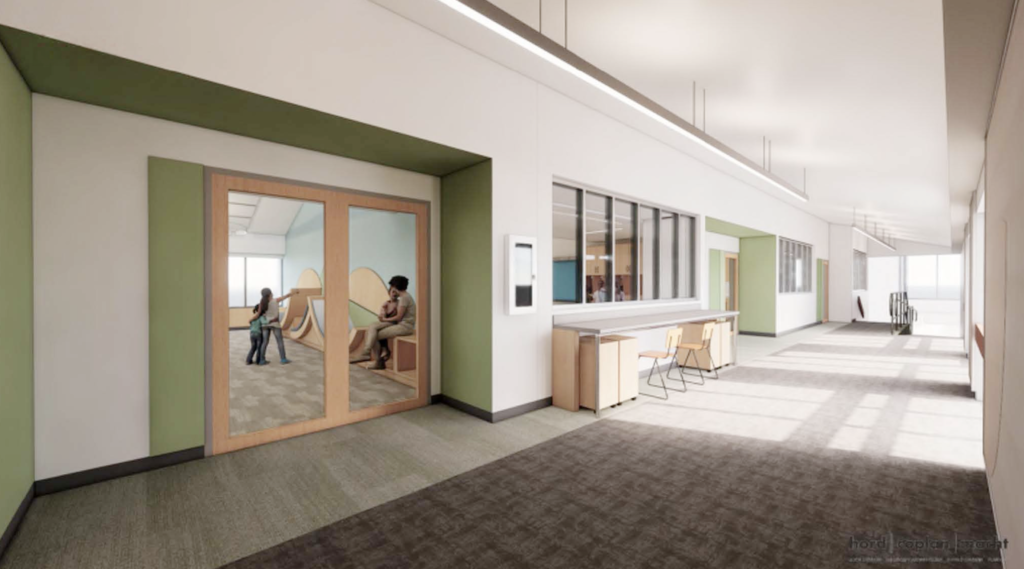Arts: Visual Arts
The Visual Arts program focuses on skill development and the enhancement of creativity.
To that end, we offer entry level courses in a wide variety of media. Advanced study is available in several areas, and students interested in pursuing work in-depth should consider Junior Portfolio and Senior Studio. Students are encouraged to record their ideas in journals and sketchbooks and to assemble portfolios containing a history of their creative accomplishments.
Requirements
- Students are required to complete four semesters in the arts, although most take more. Ninth graders select one arts course each semester from foundation electives in music, theater, and the visual arts. They may also join instrumental and choral ensembles, participate in theater productions in winter and spring, and take advanced classes.
- Upperclassmen must complete their arts requirements prior to the second semester of their senior year. Independent studies are limited and are only available to students who have fulfilled their arts requirement and wish to pursue advanced level work in an area of special expertise.
- All students should read course descriptions carefully to determine eligibility. Accelerated courses are so designated. Please note that certain elective courses require a materials fee.
Senior Studio (Accelerated)
Grade: 12 • Prerequisite: Permission of the department.
This accelerated course is for highly experienced students who may choose to complete a portfolio for college applications, but who definitely wish to create an independent body of work to be exhibited during the spring in the Senior Shows. Students develop essential questions based on formal or conceptual ideas and are free to create in media of their own choosing, integrating skills developed in earlier arts classes. The emphasis is on critical and analytical thinking and the development of a personal style. The course is open to Visual Arts students with experience in 2-D, 3-D, or arts technology courses. An ability to work independently and outside of class time is essential. The completed body of work will be exhibited during the spring in the Senior Shows.
21st Century Maker Skills
Grades: 10-12
In this course, students will embark upon a journey of exploring, creating, and researching using 21st century tools and technologies. Students will learn how to design and create 3-dimensional art and craft elements using a variety of tools such as a CNC router, Laser cutter, band saws, and a multitude of other tools available in our modeling and fabrication laboratory. A strong emphasis is placed on student-generated design and conceptual ideas for each assignment, including carefully planned preliminary sketches.
Art History: Recurring Themes
Grades: 10-12 •This course can be taken for arts or history credit.
More than ever before, we live in a world of man-made appearance, and whether we are conscious of it or not, what we see affects us. In this course, students will develop visual literacy and learn to recognize how various cultures have expressed and perpetuated many deeply held values through art and architecture. The ultimate question is this: how does art (from painting and architecture to advertising and fashion) influence our own sense of reality and shape our own desires? To approach this question in a manageable way, students will examine three or four major themes that recur throughout art history, such as Sacred Space, The Body, Power & Protest, Gender & Identity, and The Environment. They will study a broad range of works, comparing the ways artists from different time periods and cultures have responded to each theme. The class will discuss, read, and write about art, watch videos and film clips, and take a field trip or two to see some art in person. (Readings will be provided in class.)
Ceramic Sculpture
Grades: 9–12 • This course may be repeated with permission of the instructor.
In this course, students will engage with various ceramic materials and processes, while examining and creating three-dimensional forms. They will use the elements and principles of art as starting points for discussions around how objects are seen and perceived in three-dimensional spaces, and ultimately, “What makes a good Sculpture?”
Ceramics
Grades: 9-12 • This course may be repeated with permission of the instructor.
Students of ceramics become acquainted with the basic techniques and skills of using clay to create both functional and non-functional objects. Design principles, hand-building methods, safety, and studio etiquette will be covered. In the second half of the term, basic glaze theory and some wheelwork are explored. An emphasis is placed on personal expression and skill consistency. Students will keep a sketchbook/journal throughout this course and will record all works in a digital portfolio.
Darkroom Photography
Grades: 10-12 • All students are required to have a 35mm camera whose aperture, shutter speed, and film speed can be controlled manually; the school will rent cameras to students who need them.
This course introduces students to black and white film photography and 35mm SLR camera techniques. Students learn how to determine a correct exposure, control depth of field and motion, process film, and finally, learn the various procedures to make a print from a black and white negative. They are asked to consider photography as a method for personal expression while also examining photography as a means of visual communication. Grades and comments are based on assigned projects and student growth in technical and communication skills as measured by a series of group critiques conducted throughout the term.
Design Thinking
Grades: 9-12
Design is everywhere — in books, at the supermarket, on the interstate, and on the internet. Students learn about design concepts in a hands-on manner that emphasizes construction, clarity, composition, and critique. They focus on the process of making things using a design thinking model. Real world examples and experiences are worked into the course as much as possible, including a field trip to IKEA.
Digital Photography: Personal Expression
Grades: 9-12
This class introduces students to photography as creative expression, using photography as a means to communicate an idea, a message, or an emotion. Students will learn camera functions, including how to determine a correct exposure and how to control depth of field and motion. They will be introduced to Adobe Photoshop, Camera RAW, and Adobe Lightroom techniques. Topics will include staging and lighting considerations, collage/montage, and beginning animation techniques. Students will explore creating images that incorporate the subjective view of the photographer. Grades and comments are based on student growth as measured by project work, and a series of group critiques conducted throughout the term.
Drawing
Grades: 9-12
How do we view the world around us? Drawing is about seeing; it’s about careful observation and perception. This course deals with that world of seeing, observing, and perceiving. Students will experiment with charcoal, pencil, pen and ink, and pastels while introducing techniques and skills to enable them to gain confidence in their visual expression.
Graphic Design
Grades: 9-12
This course introduces basic skills and key concepts relating to the creation of visual media for use in print and online. Students develop their understanding of graphic design concepts while utilizing industry-standard software packages such as Adobe InDesign, Illustrator, and Photoshop. They are introduced to concepts related to visual design through a series of exercises and assignments. Assuming the role of graphic designer, students complete a number of real-world design problems, such as: the production of logos, posters, and magazine page layouts. Student work will be assessed on the basis of how well each student has satisfied the requirements of each assignment, and critiques will be conducted periodically throughout the semester.
Painting
Grades: 9-12
This class is devoted to enriching a student’s development as an artist through the practice and study of painting in oils and acrylics. Students learn about the basic tools and techniques used in painting and will create a series of works of increasing complexity. They work primarily from life, beginning by exploring the ideas of realism and believability. As the class progresses, students will begin to delve into the murkier depths of painting, known as expression, eventually merging the two with a work of personal significance.
Woodworking
Grades: 9-12
In this course, students learn basic woodworking concepts and skills. Safe studio practices are emphasized. The main thrust of this course is the logical process of designing and crafting in wood. Three major projects are usually completed in the course, with some students exceeding that number. A strong emphasis is placed on student-generated design and conceptual ideas for each assignment, including carefully planned preliminary sketches.
Winter Arts Course
Figure Drawing
Grades: 10-12 • Prerequisite: Painting or Drawing or permission of the department.
This intensive study of drawing from the model meets two times a week after school during the winter sports season (from early November through February). Using a variety of drawing media, including pencil, charcoal, pen and wash, pastel, watercolor, and tempera, students explore gesture, proportion, mass, foreshortening, portraiture, and composition. Opportunities for expressive interpretation of the figure occur in the final portion of the course.
Ceramics
Grades: 9-12
Students of ceramics become acquainted with the basic techniques and skills of using clay to create both functional and non-functional objects. Design principles, hand-building methods, safety, and studio etiquette will be covered. In the second half of the term, basic glaze theory and some wheelwork are explored. An emphasis is placed on personal expression and skill consistency. Students will keep a sketchbook/journal throughout this course and will record all works in a digital portfolio.
Darkroom Photography
Grades: 10-12 • All students are required to have a 35-mm camera whose aperture, shutter speed, and film speed can be controlled manually; the school will rent cameras to students who need them.
This course introduces students to black and white film photography and 35mm SLR camera techniques. Students learn how to determine a correct exposure, control depth of field and motion, process film, and finally, learn the various procedures to make a print from a black and white negative. Students are asked to consider photography as a method for personal expression while also examining photography as a means of visual communication. Grades and comments are based on assigned projects and student growth in technical and communication skills as measured by a series of group critiques conducted throughout the term.
Digital Photography: Photo Documentary
Grades: 10-12 • The school will rent cameras to students who need them.
This class introduces students to representational documentary photography, and the use of the computer as a photographic tool. Students learn camera functions, including how to determine a correct exposure and how to control depth of field and motion. Students will be introduced to Adobe Photoshop, Adobe Camera Raw, and Adobe Light Room. At the same time, they will explore photography as a means of documenting reality, and exploring how images can tell a story, capturing the world as it exists, without directing or editing the scene. Grades and comments are based on student growth as measured by a series of projects and group critiques conducted throughout the term. The school will rent cameras to students who need them.
Drawing
Grades: 9-12
How do we view the world around us? Drawing is about seeing; it’s about careful observation and perception. This course deals with that world of seeing, observing, and perceiving. Students will experiment with charcoal, pencil, pen and ink, and pastels while introducing techniques and skills to enable them to gain confidence in their visual expression.
Illustration and Sequence
Grades: 9-12
This is a course about communicating ideas through images. Students will focus on drawing and collage techniques that lead them to creating illustrations about both personal and universal ideas. The class will spend a significant amount of time looking at contemporary artists and historical illustrators to understand history, technique, and style. Students will also explore how pictures, when grouped together and put in an order, can be used to tell stories, as seen in books, graphic novels, and animation.
Junior Portfolio (Accelerated)
Grade 11 • Prerequisite: Permission of the department.
This accelerated course is designed for second-semester juniors who wish to pursue work toward the completion of a portfolio for their college applications or for archival purposes. Students should come to this class with solid experiences in 2-D, 3-D, or arts technology courses. Assignments are designed to enhance skills and experience and to develop a personal aesthetic and unique approach to art-making. The ability to work independently and outside of class time is essential.
Making About: Now
Grades: 10-12 • This class is offered in alternate years and will not be offered this year, but will be offered in 2025-2026.
This team taught course will begin not with a visual arts discipline but with ideas. We will make art — both about and from the daily newspaper using both two dimensional techniques like drawing, printmaking, painting, digital maker tools and collage, and three dimensional techniques like Papier-Mâché as well as installation. This class will take over the Arts Center using all studios for a less discipline-specific approach to making.
Metal Fabrication and Manipulation
Grades: 10-12
This course allows students to learn basic techniques, design considerations, and safety skills while working with ferrous and non-ferrous metals, and some non-traditional materials to create both personal and sculptural objects. This study includes cutting, shaping, smithing, enameling, and soldering methods for wire and sheet stock. Students will be expected to work with sharp tools and hot objects.
Sculpture
Grades: 9-12
In this course, students will engage with various sculptural materials and processes, while examining and creating three-dimensional forms. They will use the elements and principles of art as starting points for discussions around how objects are seen and perceived in three-dimensional spaces, and ultimately, “What makes a good Sculpture?”
Surface Design
Grades 9-12
Surface Design is a truly interdisciplinary workshop, combining handmade and digital techniques in printmaking, ceramics, and two- and three-dimensional design, by using digital and fabrication technologies in the Adobe Suite, a laser cutter, and a CNC router. Projects might range from intricate patterned and textured glaze work to three dimensional applications of stencil printing. This team-taught class takes over the Arts center using four different studios.
